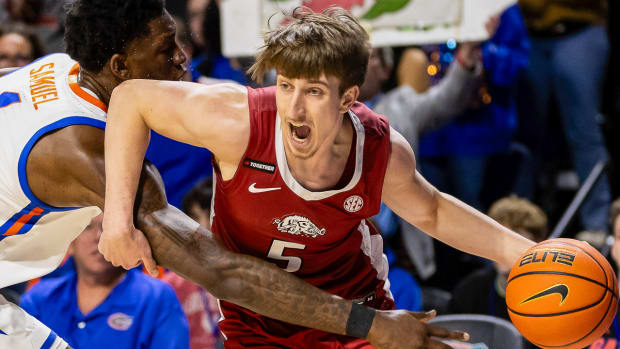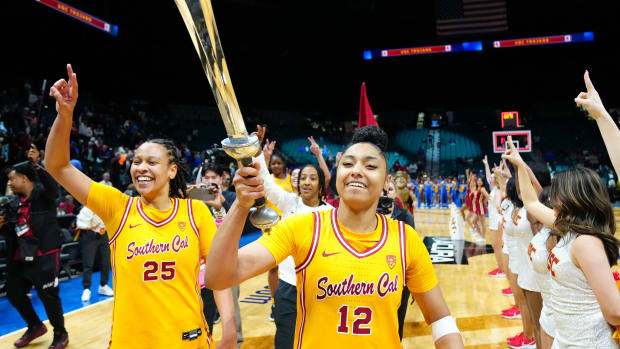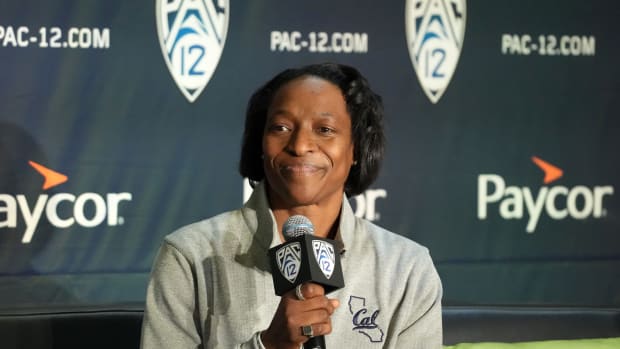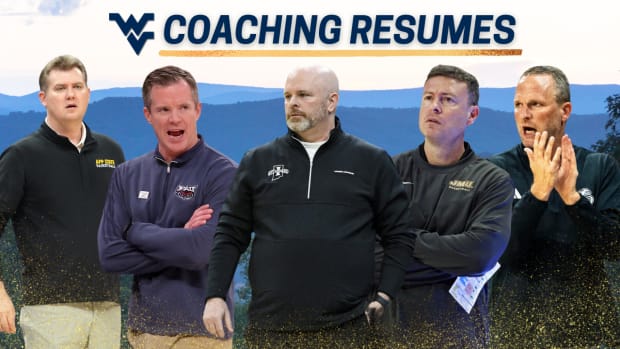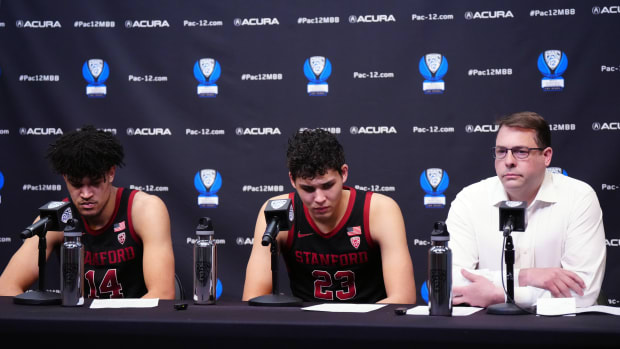Two of a Kind: Kansas thriving thanks to guards Graham and Mason
This story originally appeared in the Jan. 9, 2017, issue of Sports Illustrated. You can subscribe to the magazine here.
You have reached your limit of 4 premium articles
Register your email to get 1 more
The first move, when constructing an ideal starting lineup for a national-title contender, should be to find a high-quality point guard—and the second move should be to find another high-quality point guard. It’s not a formula that works in the NBA, but the past four college champs started duos that could each handle the point: Villanova had Ryan Arcidiacono and Jalen Brunson in 2016, Duke had Tyus Jones and Quinn Cook in ‘15, UConn had Shabazz Napier and Ryan Boatwright in ‘14, and Louisville had Peyton Siva and Russ Smith in ‘13.
The next in line could very well be No. 3–ranked Kansas, which has 5' 11" senior Frank Mason III, a front-runner for national player of the year who was averaging 19.8 points and 5.9 assists at week’s end, starting alongside 6' 2" junior Devonte’ Graham (12.5 points, 4.5 assists).
Yet unlike the blue-blood programs that typically shop for guards at the Five-Star Boutique—that’s where UCLA picked up magician Lonzo Ball, Kentucky got De’Aaron Fox and Isaiah Briscoe, and Duke found Frank Jackson and Grayson Allen—the Jayhawks came by theirs serendipitously, and without regard for brand names. There is no blueprint for what Kansas did; there is only a story of how the most atypical KU backcourt and the ideal, contending backcourt are one and the same.
Forged in Pin Oaks
Kansas’s coaches have a reliable way to irk Mason: When an opposing player’s bio intersects with his, they’ll make a comment during their scouting report along the lines of, “This is the toughest kid to come out of [example—Virginia] in years.”
“Mannnnn, Coach,” Mason will say, gruffly. “Don’t play yourself.” Meaning: Don’t be delusional. The toughest player from Virginia is sitting right in front of you.
Petersburg, Va. (pop. 32,477), is a 24-mile drive south from Richmond. Just east of Petersburg’s downtown, after a right turn off State Highway 36 before the Civil War battlefield site, a sign welcomes visitors to Pin Oaks Estates—estates being a euphemism for a public housing development of two-story duplexes. Mason’s father, Frank Jr., served much of his son’s childhood in jail on various drug charges, while his mother, Sharon Harrison, raised eight kids in Pin Oaks. After a 2001 fire ravaged the apartment Mason lived in as a young child, the family moved into one directly across the street from the Estates’ two asphalt basketball courts.
There was nightly action on the main court, which was surrounded—almost claustrophobically so—by a high, chain-link fence set less than a foot beyond the out-of-bounds lines. Mason scored enough there, in games with no fouls called, to be nicknamed the Phenom. But the Most Frank Mason III Story from Pin Oaks was based on a miss. As a fifth-grader he was shooting against another kid to secure the final spot in a pickup game. He lost the shootoff but refused to step outside the fence. “I deserve to play,” he declared, “so I’m gonna play.” A fight broke out; punches were thrown; the other kid yielded; and Mason played. He was hardly sportsmanlike back then, but he says he had a credo: “There was no way I was gonna get punked for a spot on the court.”
Bracket Watch: Villanova, Kansas, Baylor, UCLA begin 2017 on top line
The-Raeford-to-Raleigh Escape
Train your eyes on Kansas’s point guards during any game, and you’ll see not just contrasting styles of play—Mason, the bullish attacker who has evolved from pure scorer to complete, lead guard; Graham, the bouncy speed-shifter who has evolved from pure point to combo creator-scorer—but also contrasting expressions. “A pit bull look” is the way Mason describes his mean-mugging mien, even though he insists he is not actually mean, “versus a happy, clown face on Devonte’.”
“Frank looks way tougher than I do,” says Graham, who also thinks of himself as tough. “It’s just because I’ve got the baby face and I’m always smiling.” Graham says he hasn’t had much to feel down about lately. He knows that he’s been fortunate to escape some unfavorable situations—and that the first and most crucial escape happened just before he was born.
On Feb. 22, 1995, Dewanna King was 14 and sitting on the passenger side of the front seat of a U-Haul truck, braving the pain of contractions by squeezing the right hand of her 12-year-old sister, Mashonda, in the middle seat. Their mother, Doris, was driving north on Highway 210 toward Raleigh.
The trio was fleeing the Raeford, N.C., home where Doris was in what had become an unsafe relationship. An incident the previous night had been her breaking point, and with Dewanna two weeks from her due date, Doris decided that house was no place to raise another child. She told her daughters to head to the school bus stop the next morning, wait until they saw their stepfather leave for work and then return home to pack while she sought a ride to a U-Haul office and a police officer to protect her in case her husband came back before she could get away. Raeford was a 4,300-person town where everyone knew everyone, and when would-be helpers were reluctant to get involved that day, Doris told them, “Either you’re going to get in the middle of it or you’re probably going to find me dead.”
Dewanna’s contractions began 20 minutes after they hit the road, but she feared they would be prevented from escaping if they went to the nearest hospital, which was in Fayetteville. “We can’t stop,” she said. They pushed on for Raleigh, where they had a safe haven with relatives, even though it was 70 miles away. Upon arriving in the city, Dewanna went straight from the U-Haul to a hospital wheelchair to the delivery room. Devonte’ was born that night.
In the Shadow of Moses
Petersburg High’s most famous alum is Hall of Fame center Moses Malone, who carried the Crimson Wave to undefeated seasons in 1972–73 and ‘73–74, then jumped straight to the ABA. In the school’s current gym, which opened the fall after Malone’s graduation, a banner with his number 24 hangs in the rafters.
It was in that gym, as a fifth-grader in 2005, that Frank Mason III dominated an elementary school tournament and impressed AAU coach Michael Blackwell enough that he asked Mason’s mother if her son would join his program, Team Loaded. “That,” Harrison replied, indicating that her son already had a certain degree of autonomy, “is up to Frank.”
Blackwell told Mason something that day that he has never forgotten: “This game can take care of you and your family. It may not put a dollar in your pocket right now, but if you do it the right way, it eventually will.” Mason bought in, thrived with Team Loaded, led the state in scoring during his junior year and came the closest of any PHS player to Malone’s record of 2,124 career points. (Mason finished with 1,901.)
While Mason was not on a Malone-like trajectory—as a 5' 11" scoring guard, unranked by the major recruiting services, he had no offers from power-conference schools—he was at least on a route that might eventually provide for his family, which by his senior year included a newborn son, Amari, whom he had with a former girlfriend. In November 2011, Mason signed a national letter of intent with Towson, where he might have become a prolific enough mid-major scorer to open up professional opportunities.
But Mason never made it to Towson. He narrowly failed a government class in his final semester at Petersburg, ensuring that he’d neither graduate on time nor academically qualify for Division I. “That was one of the first times I’d ever seen Frank crushed,” says his stepfather, Bernard Gregory, who attended a meeting with Mason, the government teacher and school administrators. “He was in tears, asking, ‘What can I do?’”
The teacher declined to let Mason redo his coursework. So he enrolled in summer school in order to graduate, got a job at McDonald’s to help support Amari, enrolled for the following year at Massanutten Military Academy to get his academics in order and headed back on the AAU circuit to reset his recruitment. “That was when Frank went from a young man to a man,” Blackwell says. “Some people might have quit. It made him say, I need to wake up.”
Free D’Tae
If Mason was undersized, Graham was miniature: 5' 3" as a freshman at Raleigh’s Broughton High and just 5' 11" during his post-junior-year summer, the most important recruiting period. Graham’s size 14 feet suggested he would get bigger, “but even heading into his senior year,” says his best friend from high school, Steven Thornhill, “it was like, Wow, he still hasn’t really grown. Maybe it’s never going to happen.”
Graham was a talented enough point guard—he ran the show for Garner Road, John Wall’s former AAU program—that he earned mid-major offers. In November 2012 he accepted the best one he had, signing with Appalachian State. But after he broke out as a senior star at Broughton, he wanted to re-open his recruitment and called Appalachian State coach Jason Capel, twice, to ask for a release from the national letter of intent.
Capel wouldn’t budge, partly due to his suspicion that N.C. State had violated NCAA rules by contacting Graham after he signed. (The Wolfpack denied reaching out to Graham.) A statement Capel issued in September 2013 read in part, “Due to our concerns that these rules were not followed and the fact that we had turned away all other potential student-athletes that could have capably filled [Graham’s] spot on the roster, we denied his request for a release.”
Rather than play for Capel, Graham chose to take a prep year at Brewster Academy in Wolfeboro, N.H. But as the saga dragged on and he remained off-limits to recruiters through the 2013–14 season, it became such a psychological burden that his mother persuaded him to speak to a counselor.
Meanwhile, King launched a grassroots Free D’Tae campaign, making T-shirts—white, with red-and-black text on the front—and spreading the message on social media. When Graham’s extended family traveled to see him play for Brewster in the City of Palms Classic in Fort Myers, Fla., in December 2013, they were wearing the FREE D’TAE shirts at a mall when a shopper approached them and asked, “Is somebody in jail?’”
“No,” King replied. “My son is just locked in a contract.”
Hoop Thoughts: What is happening to home court advantage?
The Fourth Option
Scene from late November 2016: Kansas coach Bill Self calls assistant Kurtis Townsend into his office to rehash what led the Jayhawks to recruit Mason in the summer of 2013.
Self: “When Frank came out, was that the same year we were recruiting Cat Barber and Chris Jones?”
Townsend: “And Demetrius Jackson. Frank was kind of our fourth option.”
Kansas needed point guard help, and things weren’t breaking the Jayhawks’ way. Jones, the No. 1 junior college prospect, committed to Louisville. Barber, the No. 24–ranked high school recruit, committed to N.C. State. Jackson, the No. 33 recruit, committed to Notre Dame.
Self: “That left us really kind of—”
Townsend: “Scrambling. Then we were recruiting Jordan McLaughlin [for the following class], who ended up canceling our visit and committing to USC. But I went to see him [at the Adidas Fab 48] in Vegas; Frank was playing against him, and Frank kicked his ass.... I knew Frank’s AAU coach, Ty White, so I called him and asked, ‘Does that little dude with the braids play like that all the time?’ He said, ‘Every day, Coach. He don’t know no better.’ ... I went and saw him twice more, and each time he was good.”
Self: “Kurt came back and told me, Frank’s better than anybody we’ve been recruiting.”
The Jayhawks’ fan base, however, was less than thrilled by Mason’s commitment on Oct. 7, 2012, when he was a three-star guard ranked 131st in his class by Rivals.com. The comments on KUSports.com’s story the next day were mostly skeptical or negative, with one fan proposing nicknames for Mason that included “Red Shirt [sic] then Transfer” and “This Ain’t Towson.”
A user with the handle Wave79—Mason’s stepfather—fought back. “I will assure you that Kansas will not be disappointed in Frank Mason,” Gregory wrote. “I can personally tell you that there are not 130 high school seniors better than him.... You ain’t gonna see a tougher guard at his size.”
The Most Timely of Firings
In the end, it was fortuity that freed D’Tae. Capel was fired in March 2014, and the coach that replaced him at Appalachian State, Jim Fox, granted Graham his release that April. “The timing was a blessing for us,” says Self, “because if Devonte’ had been released right away [in 2013], someone else would’ve done a better job recruiting him.” Kansas, which had been rebuffed in its recruitment of top 2014 point guard Tyus Jones and was losing point guard Naadir Tharpe to a transfer, jumped in on Graham and secured his commitment on May 2.
Although he arrived with less hype than the eventual one-and-done freshmen in his class, Kelly Oubre and Cliff Alexander, Graham soon established that he belonged. When ex–Navy Seals led a weekend session of Kansas’s annual preseason boot camp in September 2014, they gave Graham an award for being the team’s best leader, despite the fact that he had yet to play a college game.
As a sophomore Graham started in the Jayhawks’ backcourt alongside Mason, giving Self an arrangement that reminded him of his final season at Illinois, in 2003–04, when Dee Brown and Deron Williams shared the ball seamlessly and made it hard to define who was the one and who was the two. “I don’t know that they’re the best or the most talented,” Self says of Mason and Graham, “but I don’t think there’s two guards out there that play better together.”
Or that complement each other as well defensively, as Mason is better at smothering ballhandlers—in his words, “Letting them know that I’m there”—and Graham is better at tracking foes off the ball. At Oklahoma on Feb. 13, 2016, it was Graham who drew the assignment of checking national player of the year front-runner Buddy Hield, the 6' 4" guard who’d scored 46 points at Allen Fieldhouse in January. Graham held Hield to 24 points, on 5-of-15 shooting, while scoring a career-high 27 in what became his signature performance. When he was named the Big 12 tournament’s most outstanding player a month later, all the nights Graham had spent stressing—wondering, Maybe I should’ve just stuck with Appalachian State—seemed like an eternity ago.
In With A Bang: The story behind the five most exciting seconds of 2016
#BIFM
When Kansas’s managers distribute new Adidas gear—a new travel sweat suit, say—they typically write each player’s number on the inside tags. But lately, for Mason, they’ve been writing #BIFM. This is a part of his legend that precedes his being a college player of any note.
In March 2014, RedHead, an obscure rapper from Hopewell, Va., posted a song on YouTube entitled “Frank Mason.” It begins with a voice-mail intro from Mason, and then the line “B----, I’m Frank Mason” is repeated 28 times in 3:43. It went largely unnoticed until 2015, when Grantland writer Mark Titus catapulted it into meme- and hashtag-dom.
When the track debuted, Mason was a 5.5-points-per-game scorer who was merely being celebrated for having made it from Pin Oaks to D-I. Now he’s the nation’s most unstoppable guard and the author of the season’s signature shot to date: a game-winning, 15-foot jumper with 1.8 seconds left to beat Duke on Nov. 15. A caravan of family members had traveled to that game, including Amari, now five, who lives with his mother in Virginia. He told his father afterward, “Dad, I seen you make the shot, and everybody went crazy!” And while Mason never listens to his eponymous song anymore, it remains part of his teammates’ lexicon. In a video that surfaced of Mason getting mobbed in Kansas’s locker room, someone off-camera yells, “B----, I’m Frank Mason!”
Against Duke, Graham had been struggling with cramping and Mason seized control of the game, scoring on a series of isolations in the final minutes. Self says his guards can sense when it’s not the other one’s night, and that Mason’s most overt displays of toughness—his #BIFM moments—”are when nothing is happening for us on offense. That’s when Frank says, O.K., I’ve gotta take over.”
In Concert
Scene from late in the evening of Dec. 20, 2016, when the Jayhawks are 10–1.
Mason, Graham and redshirt sophomore guard Malik Newman are on Instagram Live from a room in Kansas’s new, $12 million basketball dormitory, freestyling over YouTube instrumentals during their winter break. Mason has his hoodie up, his delivery is low-key, and he introduces himself as Extreme Zero. He christened the Jayhawks’ digs the Mansion when he stood up at a thank-you dinner for the principal donors and told them he never expected he’d have the opportunity to live somewhere that posh. His freestyling on this night includes references to the Mansion and the highway leading to Pin Oaks. (“The 36 is where I’m at.”)
Graham is buoyant and shirtless, exposing the FOREVER GRATEFUL tattoo across his chest—a tribute to his mother and grandmother for getting him to this stage of his life. He intros himself as D-Teezy and begins riffing off the comment stream from the broadcast’s 200-plus viewers. He spots a compliment that he likes and spits out: “Best backcourt in the nation, on Live/N----- ain’t f------ with us, anytime.” They alternate between rapping and laughing at the amateur-grade bars. What they lack in refinement, they make up for with their sense of timing. When one guard is running out of ideas, the other is always there beside him, to take control of the beat.





